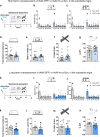Synaptic mechanisms underlying onset and progression of memory deficits caused by hippocampal and midbrain synucleinopathy
- PMID: 37328503
- PMCID: PMC10275870
- DOI: 10.1038/s41531-023-00520-1
Synaptic mechanisms underlying onset and progression of memory deficits caused by hippocampal and midbrain synucleinopathy
Abstract
Cognitive deficits, including working memory, and visuospatial deficits are common and debilitating in Parkinson's disease. α-synucleinopathy in the hippocampus and cortex is considered as the major risk factor. However, little is known about the progression and specific synaptic mechanisms underlying the memory deficits induced by α-synucleinopathy. Here, we tested the hypothesis that pathologic α-Synuclein (α-Syn), initiated in different brain regions, leads to distinct onset and progression of the pathology. We report that overexpression of human α-Syn in the murine mesencephalon leads to late onset memory impairment and sensorimotor deficits accompanied by reduced dopamine D1 expression in the hippocampus. In contrast, human α-Syn overexpression in the hippocampus leads to early memory impairment, altered synaptic transmission and plasticity, and decreased expression of GluA1 AMPA-type glutamate receptors. These findings identify the synaptic mechanisms leading to memory impairment induced by hippocampal α-synucleinopathy and provide functional evidence of the major neuronal networks involved in disease progression.
© 2023. The Author(s).
Conflict of interest statement
The authors declare no competing interests.
Figures





Similar articles
-
Modelling cognitive deficits in Parkinson's disease: Is CA2 a gateway for hippocampal synucleinopathy?Exp Neurol. 2020 Aug;330:113357. doi: 10.1016/j.expneurol.2020.113357. Epub 2020 May 11. Exp Neurol. 2020. PMID: 32437708
-
Ginsenoside Rb1 prevents MPTP-induced changes in hippocampal memory via regulation of the α-synuclein/PSD-95 pathway.Aging (Albany NY). 2019 Apr 4;11(7):1934-1964. doi: 10.18632/aging.101884. Aging (Albany NY). 2019. PMID: 30958793 Free PMC article.
-
Behavioral characterization of A53T mice reveals early and late stage deficits related to Parkinson's disease.PLoS One. 2013 Aug 1;8(8):e70274. doi: 10.1371/journal.pone.0070274. Print 2013. PLoS One. 2013. PMID: 23936403 Free PMC article.
-
Extracellular alpha-synuclein oligomers modulate synaptic transmission and impair LTP via NMDA-receptor activation.J Neurosci. 2012 Aug 22;32(34):11750-62. doi: 10.1523/JNEUROSCI.0234-12.2012. J Neurosci. 2012. PMID: 22915117 Free PMC article.
-
Ageing, hippocampal synaptic activity and magnesium.Magnes Res. 2006 Sep;19(3):199-215. Magnes Res. 2006. PMID: 17172010 Review.
Cited by
-
Glutamatergic synaptic resilience to overexpressed human alpha-synuclein.NPJ Parkinsons Dis. 2025 Aug 12;11(1):238. doi: 10.1038/s41531-025-01085-x. NPJ Parkinsons Dis. 2025. PMID: 40796780 Free PMC article.
-
Integrating plasma circulating protein-centered multi-omics to identify potential therapeutic targets for Parkinsonian cognitive disorders.J Transl Med. 2025 May 12;23(1):535. doi: 10.1186/s12967-025-06541-z. J Transl Med. 2025. PMID: 40355913 Free PMC article.
-
Brain and behavioural anomalies caused by Tbx1 haploinsufficiency are corrected by vitamin B12.Life Sci Alliance. 2024 Nov 20;8(2):e202403075. doi: 10.26508/lsa.202403075. Print 2025 Feb. Life Sci Alliance. 2024. PMID: 39567195 Free PMC article.
-
Carvacrol attenuated haloperidol-induced Parkinson's disease via TNF/NFκβ-NLRP3-mediated pyroptosis.Lab Anim Res. 2025 Feb 5;41(1):7. doi: 10.1186/s42826-025-00237-7. Lab Anim Res. 2025. PMID: 39910608 Free PMC article.
-
Hippocampus and olfactory impairment in Parkinson disease: a comparative exploratory combined volumetric/functional MRI study.Neuroradiology. 2024 Nov;66(11):1941-1953. doi: 10.1007/s00234-024-03436-6. Epub 2024 Jul 24. Neuroradiology. 2024. PMID: 39046517
References
LinkOut - more resources
Full Text Sources
Miscellaneous

